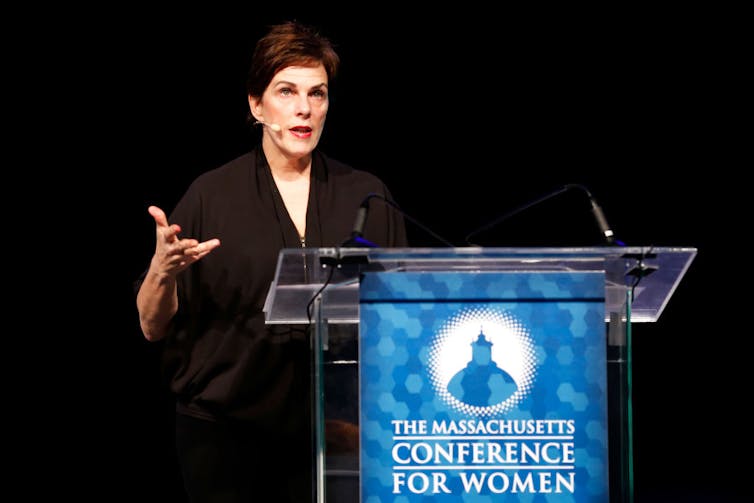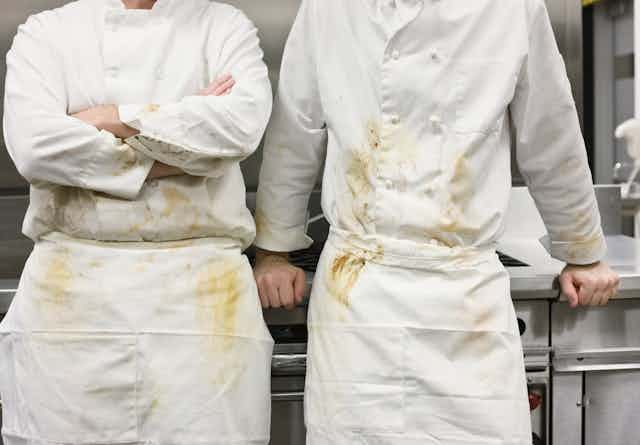When the The New York Times and The Boston Globe recently published exposés in which employees of award-winning chef Barbara Lynch described their abusive work environments, we weren’t surprised.
Anyone who has spent years working in restaurants probably wouldn’t be surprised, either.
As sociologists who study the culinary industry and its workers, we recently published research showing that many kitchen staffers come to view mistreatment and abuse as a mundane – and often inevitable – part of working in restaurants.
‘Showers of slaps’ and ‘grab-ass’
Much of the reporting provided damning accounts of Lynch’s own behavior – her alleged mistreatment of employees, tirades, threats, groping and sexual innuendos.
But while Lynch may be in the spotlight today, she and her alleged behaviors are, unfortunately, closer to business as usual in restaurant kitchens, where a culture of violence has been normalized.
Numerous articles and chef memoirs dating as far back as the late 1800s have detailed everyday forms of abuse in restaurants. For example, pioneering French restaurateur Auguste Escoffier wrote in his memoir that his first chef “believed that it was impossible to govern a kitchen ‘sans une pluie de gifles’” – without a shower of slaps.
Some, such as Anthony Bourdain’s memoir “Kitchen Confidential,” even romanticize these behaviors. At one point, Bourdain fondly recalls a kitchen he worked in early in his career as having an “atmosphere [that] was not unlike a Pinero play, very jailhouse, with a lot of grab-ass, heated argument, hypermacho posturing and drunken ranting. Two burly men who’d just as soon kill you as look at you, when talking to each other, would often nestle a hand tenderly next to the testicles of the other, as if to say, ‘I am so not gay – I can even do this!’”
The allegations against Lynch are only the latest in a long string of high-profile chefs and restaurateurs who have been accused of cultivating similar physically, psychologically and sexually violent workspaces.
Mario Batali, for instance, was accused in 2019 by an employee of groping and indecency, charges that he was acquitted of in 2022 and resolved with a civil settlement.
Oakland chef Charlie Hallowell and New York restaurateur Ken Friedman also came under fire during the #MeToo era, with each accused of sexual harassment and assault. Hallowell ended up selling two of his restaurants and penned a public apology, while Friedman shuttered a flagship restaurant and paid claims to 11 former employees.

In our own research, we wanted to learn more about how workers deal with toxic kitchen culture. Do they ever push back? Do they flee? Or do they put their heads down and simply rationalize it as part of what they signed up for?
If you can’t take the heat …
There are obvious economic realities that prevent many from leaving violent workspaces. After all, most everyone has bills to pay.
Quitting is also hard in light of the other upsides to professional cooking, such as creativity and freedom, sensory stimulation and reciprocal joy from watching a satisfied customer eat. One sous chef we spoke with described the latter as “life-changing to me. It was addicting.”
These pressures aside, the workers we interviewed tended to see violence as a core aspect of a hardscrabble kitchen culture that has existed for generations.
Others admitted that they’ve come to expect as much after seeing the ways in which abusive chefs are glorified in the media – think Gordon Ramsay’s entertaining tongue-lashings on the show “Hell’s Kitchen,” or Ralph Fiennes’ recent portrayal of a homicidal chef in “The Menu.”
Because those we talked to saw violence in kitchens as unexceptional, most of them responded to it by sticking it out rather than resisting it. Many of them viewed enduring violence on the job as just another task on their daily to-do list.
A key element of rationalizing the violence involved justifying the perpetrator’s behavior.
There’s evidence of this in both articles about Lynch’s restaurants: Workers and the public touted Lynch as an early fighter of industry sexism, a portrayal that presented her as an ally and may have softened her blows. Her public acknowledgments of her own battles with substance abuse and childhood trauma painted her in a sympathetic light and allowed some staffers to excuse her alleged behavior.

Similar rationalizations were found in our study: A chef named Jesus, for example, recounted to us a time when his boss became so upset that, after berating his crew, he “flipped everyone off and told them to ‘go f— themselves.’” But rather than note his boss’s inappropriateness, Jesus praised him for being “straightforward” and “honest.” In doing so, Jesus excused the outburst as simply a product of honesty and emotion, rather than of a work environment that bred such behavior.
We also noticed that Lynch’s own staff rationalized their decisions to stay – despite saying they’d been subjected to abuse – because they felt that working in Lynch’s restaurants would help them find better jobs in the future. This approach was echoed by several cooks in our study – a chef named Carsen, for example, explained away the abuse he endured once at a Michelin-starred restaurant: “I was there for the experience. I wasn’t there because I was invested in the restaurant.”
Perpetuating a culture of violence
As workers endure violence in kitchens, they deal with not only the harms of being targeted, but also the psychological and emotional discomfort of remaining at a job that causes them suffering.
Studies have also shown that learning to endure violence can increase the chances of repeated abuse, as well as the incorporation of unproductive behaviors into victimized workers’ own actions. The latter can look like adopting abusive behaviors themselves or engaging in small acts of damaging rebellion, like sneaking a swig of cooking wine here or slowing the pace of work there. Cruelly, enduring violence unintentionally aids the process of making violent behavior feel and seem normal in the workplace.
So a cycle of violence perpetuates and reverberates, embedding itself deeper into the fabric of restaurant kitchens, often being passed down from one generation of cooks to the next.
Workers begin to expect it. Grant, a cook we interviewed, explained: “The abuse is normalized. And sometimes romanticized as well. … Chefs being [jerks] is common in part because that’s the expectation for what it is to be a chef. … And while it [seems] like most places are getting better, it’s still a big part of kitchen culture.”
The accusations against Lynch are not exceptional. Sadly, we think it’s likely only a matter of time before another case of an abusive high-profile chef comes to light. Outrage will occur, and then it will settle. Rinse and repeat.
But culinary brilliance and artistry need not be pre-seasoned with violence. Not venerating violent kitchens and chefs would be a start. Perhaps reporting and resisting abuse, rather than enduring it, will then become the norm.

